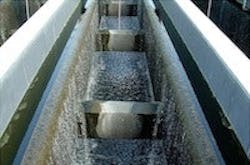Virginia WWTP Upgrades to ‘Limit of Technology’ Nutrient Removal
With a growing population in its residential and business communities putting a strain on its aging water pollution control plant infrastructure, the city of Arlington, Va., was in need of massive infrastructure upgrades.
Project Background
Arlington County’s Water Pollution Control Plant (WPCP) is located on 35 acres of land squeezed into a commercial/residential neighborhood less than a mile west of Ronald Reagan Washington National Airport. The facility treats flows from nearly all of Arlington, with nearly 20% of the plant’s flow coming from neighboring localities such as Alexandria, Fairfax County and Falls Church. Effluent from the plant is discharged into Four Mile Run to the south, which feeds into the Potomac River and, ultimately, the Chesapeake Bay.
Originally constructed in 1937, the facility had been upgraded several times throughout the years. In 2001, Arlington County officials recognized the need to address a number of long-term challenges including a growing population in its residential and business communities and insufficient treatment capacity to handle wet weather that could increase flows nearly fourfold. In a forward-looking approach, in addition to the infrastructure upgrades, the county board decided in January 2003 to proactively upgrade the plant's treatment process to provide "limit of technology" nutrient removal in advance of any requirements to do so.
The resulting planning, design and construction project was a $568-million, decade-long upgrade of the WPCP that would expand the plant’s capacity from 30 million gal per day (mgd) to 40 mgd while also reducing nitrogen to the limit of technology. This would require upgrading the plant's biological nutrient removal (BNR) 8 mg/L total nitrogen (TN) capability to meet an anticipated TN limit of approximately 3 mg/L with a concurrent low total phosphorous limit of 0.18 mg/L.
Pilot Testing Two Denitrification Filter Technologies
Engineers from Malcolm Pirnie conducted pilot testing to assess the ability of two denitrification filter technologies to achieve total nitrogen effluent limits and removal of effluent total suspended solids to ensure low effluent phosphorus concentrations. The tests were conducted in side-by-side conditions under various flows and loads, testing performance at average and peak conditions and influent phosphorus concentrations. After concluding the pilot tests, the company decided to replace the plant’s existing tertiary filters with TETRA Denite deep bed denitrification filters from De Nora Water Technologies. Seventeen Denite filters, each 12 ft 6 in. by 72 ft 4 in. with a total surface area of 15,370 sq. ft, were designed to address the treatment requirements of the WPCP.
The TETRA filtration system is a fixed-film biological denitrification process that also serves as a deep bed filtration system capable of removing oxidized nitrogen (NOx-N), total phosphorous (TP) and suspended solids (SS) to meet a high standard of effluent discharge. A single treatment solution, TETRA Denite addresses multiple wastewater treatment plant process needs by offering an economical, small footprint and virtually maintenance-free operation.
Plant Design Goes Beyond the “Limit of Technology”
The Arlington County plant is one of the first major effluent denitrification facilities achieving effluent TN less than 3 mg/L and TP less than 0.18 mg/L. Since June 2010, the plant has consistently achieved less than 2.5 mg/L TN and less than 0.1 mg/L TP. This has been accomplished by not only replacing effluent filters but also modifying all upstream processes. For example, to protect the treatment process against wide fluctuations in flow during wet weather, the plant’s design included increased equalization basin tankage and other primary treatment modifications.
Today, the plant is successfully discharging less than 1.0 milligrams of nitrogen per liter of water and less than 0.1 milligrams of phosphorous per liter into the Four Mile Run compared to 19.6 milligrams of nitrogen in 1985 before nitrogen reduction efforts commenced.
